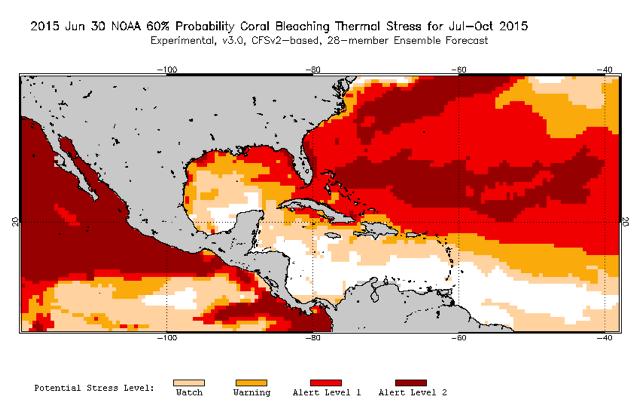- ABOUT US
- PROGRAM AREAS
- CONSERVATION APPROACH
- EDUCATION
- MULTIMEDIA
Coral Bleaching Threat Increasing in Western Atlantic and Pacific Oceans
As unusually warm ocean temperatures cover the north Pacific, equatorial Pacific, and western Atlantic oceans, NOAA scientists expect greater bleaching of corals on Northern Hemisphere reefs through October, potentially leading to the death of corals over a wide area and affecting the long-term supply of fish and shellfish. The news comes from the latest NOAA's Coral Reef Watch four-month Coral Bleaching outlook, which is updated weekly.

While corals can recover from mild bleaching, severe or long-term bleaching can kill corals. Even if corals recover, they are more susceptible to disease. Once corals die, it usually takes decades for the reef to recover -- but recovery is only possible if the reefs are undisturbed. After corals die, reefs degrade and the structures corals build are eroded away, providing less shoreline protection and fewer habitats for fish and shellfish.
"The bleaching that started in June 2014 has been really bad for corals in the western Pacific," said Mark Eakin, NOAA Coral Reef Watch coordinator. "We are worried that bleaching will spread to the western Atlantic and again into Hawaii."
Coral bleaching occurs when corals are stressed by changes in environmental conditions such as temperature, light or nutrients. The coral expels the symbiotic algae living in its tissue, causing the tissue to turn white or pale. Without the algae, the coral loses its major source of food and is more susceptible to disease. Scientists note, however, that only high temperatures can cause bleaching over wide areas like those seen since 2014.
NOAA's bleaching prediction for the upcoming months supports the findings of a paper published in the journal Science last week that examined the threat to marine ecosystems and ecosystem services under two different carbon dioxide emission pathways.
"The paper reports that even if humans limit the Earth's warming to two degrees Celsius (3.8 degrees F), many marine ecosystems, including coral reefs, are still going to suffer," said Eakin, an author on the paper. "The increase we are seeing in the frequency and severity of bleaching events is part of why the climate models in that paper predict a dire future for coral reefs."
For more information on coral bleaching and these products, visit: http://www.noaanews.noaa.gov/stories2015/20150706-coral-bleaching-threat-increasing-in-western-atlantic-and-pacific-oceans.html
About Us

The NOAA Coral Reef Conservation Program was established in 2000 by the Coral Reef Conservation Act. Headquartered in Silver Spring, Maryland, the program is part of NOAA's Office for Coastal Management.

The Coral Reef Information System (CoRIS) is the program's information portal that provides access to NOAA coral reef data and products.
Work With US
U.S. Coral Reef Task Force
Funding Opportunities
Employment
Fellowship Program
Contracting Assistance
Graphic Identifier
Featured Stories Archive

Access the archive of featured stories here...
Feedback
Thank you for visiting NOAA’s Coral Reef Conservation Program online. Please take our website satisfaction survey. We welcome your ideas, comments, and feedback. Questions? Email coralreef@noaa.gov.
Stay Connected
Contact Us
NOAA’s Coral Reef Conservation Program
SSMC4, 10th Floor
1305 East West Highway
Silver Spring, MD 20910
coralreef@noaa.gov
